NEED HELP? WE’RE AVAILABLE. CALL NOW. (253) 848 – 6000
NEED HELP? WE’RE AVAILABLE. CALL NOW.
(253) 848 – 6000
Wood-Boring Control & Prevention
Wood-boring beetles are a group of insects that lay eggs in wood, and their larvae tunnel through it as they feed, causing damage. Though neither aggressive nor carriers of disease, these destructive pests can harm wooden structures, furniture, and trees, leading to structural weakening if left untreated.
Our wood-boring beetle control services effectively identify and treat infestations, prevent re-infestation through tailored treatment and environmental modifications, and safeguard structures from the damaging effects of these pests.
Professional Wood-Boring Beetle Control Services
While wood-boring beetles don’t pose immediate health risks or physical harm, they can cause significant damage to wooden structures if left unchecked. Our comprehensive pest control packages aim to mitigate wood-boring beetle re-infestation risks and minimize ongoing beetle activity, safeguarding your property from further damage.

The Dangers of Wood-Boring Beetle Infestations
Wood-boring beetles go through complete metamorphosis, but they do all their destruction of wood in the larval stage of their life cycle. The extent of damage is not determined by how long the larva feeds, however, but by whether or not the species is capable of reinfesting the same material upon mature adult emergence out of the wood. Some species can develop into adults within one year, and others (if conditions are poor) can remain in the larval stage for 20 or more years, continually eating the wood.
The majority of these wood-boring beetle infestations occur in the crawlspace underneath a house. In this damp environment conditions can exist which will encourage beetle re-infestation. The number one cause for significant beetle damage in a crawlspace is lack of, or poorly installed vapor barrier. Without a properly installed vapor barrier the moisture in the soil creates very humid air, which permeates into the wood, creating the ideal environment for many pests, including wood-boring beetles.

Wood-Boring Beetle Identification
Wood-boring beetles include several varieties, such as: Lyctid (powder post Beetles), Anobiid (deathwatch beetles), Buprestid (flat-headed borers), and Cerambycid (round-headed borers). Generally, the mature female will lay eggs into the bark of dead or dying trees, and the eggs hatch into the larval stage. They bore into the tree and begin the slow process of eating and growing.
Some wood-boring beetles pose no threat to your home, while others can cause devastating damage. Knowing which is which can make all the difference. There are many different varieties, sizes, and shapes of wood-boring beetles, and each has a distinct type of frass. Some prefer softwoods, while others infest only hardwoods. All of these differences help in determining how to control an infestation.
Wood-boring beetles are typically identified when a customer or home inspector notices a section of wood freckled with small circular holes. This can be a cause of great concern, but in many cases, there is no real danger. These holes are caused by beetle larvae that have been inside the wood, taking considerable time to grow and pupate into an adult before chewing its way out of the wood, never to return. Other times, there is nothing left of the wood but a powdery mess.
Some species, such as the false powder post beetles, flat-headed wood borer, and ambrosia beetles do not re-infest the same wood. This means the damage they cause is typically limited and corrective treatment may not be needed. Other species, such as true powder post beetles, death watch beetles, and the round-headed borer, will reinfest the same piece of wood. This allows them to cause considerable damage over time.

Wood-Boring Beetle Control Methods
Wood-boring beetle services are performed on a case-by-case basis, as treatment options are rather limited. The most common method of treatment is surface application to exposed wood members with a residual borate insecticide. The surface of the wood must be free of any kind of sealant or paint. If the wood has been sealed or painted, it must first be sanded down to bare wood, so that the wood is able to take in the material. In some instances, it is simpler just to replace the damaged and infested wood.
Wood-boring beetles all have similar characteristics, but they are not all the same. Since the insects themselves are usually not at the surface of the wood during our investigation, identification of the species of wood-boring beetles is often based on the available evidence at hand. This evidence may consist of things like the size of the beetle emergence holes in the wood, the type of wood, the moisture content of the wood, or a number of other identifiers. Once we feel confident, we have determined if this is a re-infesting species of beetle or not, then we can begin developing a control plan.










